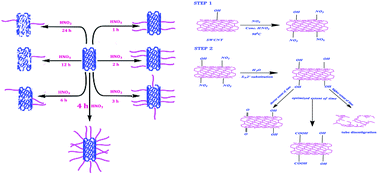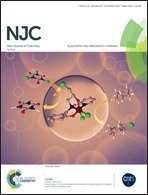New insights into the spectral, thermal and morphological analysis of time dependent structural changes during open end functionalization of single walled carbon nanotubes†
Abstract
Even though several authors have investigated the chemical derivation of single walled carbon nanotubes (SWCNTs) through their treatment with concentrated nitric acid (conc. HNO3), this paper reports hitherto unaccounted for insights in this field of study that can be achieved through a spectral, thermal and morphological evaluation of SWCNTs, functionalized at a fixed temperature for different time intervals. In this study, multiple techniques were employed to systematically evaluate the structural changes on SWCNTs with refluxing time. Furthermore, the nanotubes, specifically functionalized for different extents of time, were characterized using a combination of analytical techniques including Raman spectroscopy, thermogravimetry-mass spectroscopy (TG-MS), X-ray photoelectron spectroscopy (XPS) and ultra violet near infrared spectroscopy (UV-Vis-NIR). To arrive at an optimum reflux point, an analysis of the changes in Radial Breathing Mode (RBM), D-band & G-band of Raman spectra, TG-MS profile and Zeta potential measurements was carried out. TG-MS (of the evolved carbon dioxide) and XPS were employed, respectively, to quantify the acid groups in the functionalised SWCNTs (F-SWCNTs) and the type of functional groups attached onto the SWCNTs. While the electronic nature of the SWCNTs was analysed through the line-shape of the G-band, the 2D band of the Raman spectra and the UV-Vis-NIR spectra, their morphological characterisation was done using a high resolution transmission electron microscope (HRTEM). Exploiting the advantages of each characterization techniques, the reflux time for the effective functionalization of SWCNTs, without any compromise of their quality, was converged down to 4 h. This paper proposes a new mechanism to account for the multistage oxidation with the extension of reflux time and explain the type of functional groups attached onto the surface of SWCNTs as functionalization proceeds with time. It is also claimed that the changes in the relative concentration of functionalized groups on the SWCNT surface are directly proportional to the increase in the extent of functionalization. Significantly, this paper reports that the introduction of any desired ratio of functional groups on the surface of carbon nanotubes can be achieved by tuning the extent of functionalization.



 Please wait while we load your content...
Please wait while we load your content...